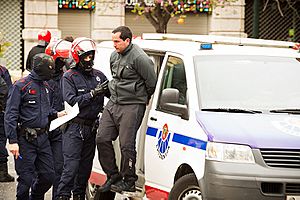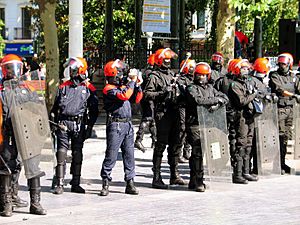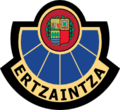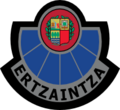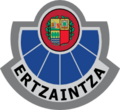Ertzaintza facts for kids
Quick facts for kids People's GuardErtzaintza |
|
|---|---|
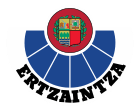
Badge of the Ertzaintza
|
|

Flag of the Ertzaintza
|
|
| Agency overview | |
| Formed | 1982 |
| Preceding agency |
|
| Annual budget | US$634.34 million (€570 million) (2015) |
| Jurisdictional structure | |
| Operations jurisdiction | Basque Country, Spain |
| Governing body | Home Office of the Basque Government |
| Constituting instrument |
|
| General nature | |
| Operational structure | |
| Headquarters | Erandio (Biscay), Basque Country, Spain |
| Ertzainas | 8,000 |
| Elected officer responsible |
|
| Agency executive |
|
| Divisions |
List
Citizen Security
Criminal Investigations Intelligence |
| Police Stations |
List
Vitoria-Gasteiz
Llodio/Laudio Laguardia/Guardia Durango Balmaseda Sestao Bilbao/Bilbo Beasain Zumarraga Tolosa Azkoitia Zarautz Hernani Donostia/San Sebastián Errenteria Irun Eibar Bergara Ondarroa Gernika Muskiz |
| Facilities | |
| Stations | 20 |
| Boats | 9 |
| Helicopters | 2 |
| Notables | |
| Anniversaries |
|
| Website | |
| http://www.ertzaintza.eus | |
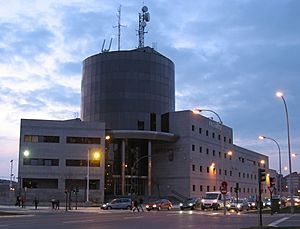
The Ertzaintza is the main police force for the Basque Country in Spain. Its name means Public Guard or People's Guard. This police force is special because it's autonomous, meaning it has its own rules and works mostly independently from Spain's national police.
An officer in the Ertzaintza is called an ertzaina. There are about 8,000 ertzainas keeping the peace in the Basque Country. They handle many tasks that national police forces usually do.
Contents
History of the Ertzaintza
Early Police Forces
The idea of the Ertzaintza started a long time ago. It began with local groups called militias. These groups were made of regular people who helped keep their towns safe.
In the 1800s, things changed a lot in Spain. There was a lot of fighting and social unrest. This led to more organized police groups being formed. Some of the first were the Miqueletes in Biscay and Guipuzcoa, and the Miñones in Alava.
After a big war called the First Carlist War, the Spanish government wanted to take over these local police jobs. They created the Civil Guard in 1844. But it was hard for them to find enough people in the Basque areas. So, the local Basque police forces continued their work.
Changes After Wars
After another war, the Second Carlist War in 1876, the Spanish government wanted more control. This meant the Basque police forces became smaller and had less power.
In 1931, the Second Spanish Republic was formed. People in the Basque Country wanted their old freedoms back. They started working on plans for their own government.
During the Spanish Civil War, in 1936, the Basque Country got its own government. One of their first goals was to create a new police force.
The Basque Interior Minister, Telesforo Monzón, helped set up this new force. It was called Ertzaña, which means "People care" in Basque. It had about 1,200 officers, some on foot and some in cars.
When the war ended in the Basque Country, the Ertzaña was stopped. The new government, led by Franco, pretended it never existed.
However, the Miñones in Alava continued their work. They helped with traffic and protected local government buildings. This was because Alava had supported Franco's side in the war.
Rebuilding the Police Force
After Spain became a democracy again, the Basque Government was brought back. In 1980, they decided to create a new police force. They used the spirit of the old Ertzaña from 1936. This new force was named Ertzaintza.
Before the Ertzaintza was fully formed, some older Basque police groups were brought back. These included the "Forales" and "Miqueletes" in Biscay and Guipuzcoa, and the "Miñones" in Alava. These groups then joined the new Ertzaintza.
Navarre, another region, became its own autonomous community. Its police force, the Policía Foral, stayed separate from the Ertzaintza.
The first officers of the new Ertzaintza were Basque citizens. This new police force grew steadily from 1982. It slowly took over policing duties, starting in the countryside and then moving into the cities.
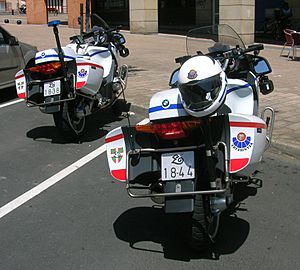
What does Ertzaintza mean?
The name Ertzaña was first created by a poet named Esteban Urkiaga. It came from two Basque words: eŕi (meaning "people") and zañ (meaning "guard").
Later, when the Basque language was standardized, the name changed slightly. The new name, Ertzaintza, comes from herri (people) and zain (guard). It's like how artzain means "shepherd" (from "sheep" + "guard"). The ending -tza is a common Basque suffix, seen in names like Osakidetza (the Basque health service).
Even though the modern spelling of "people" is herri, the "H" was left out of Ertzaintza. This was done to keep a connection to the older name, Ertzaña.
Images for kids
See also
 In Spanish: Ertzaintza para niños
In Spanish: Ertzaintza para niños



